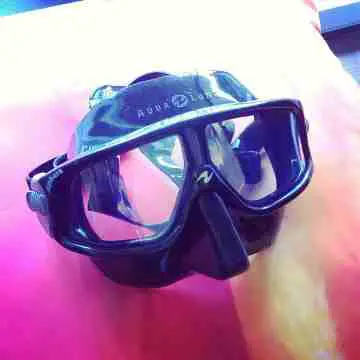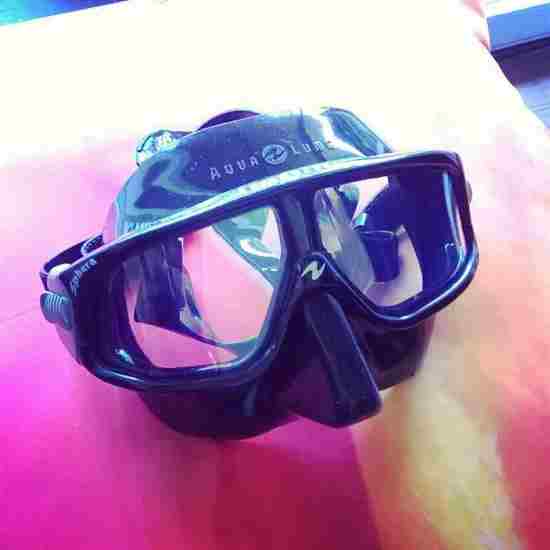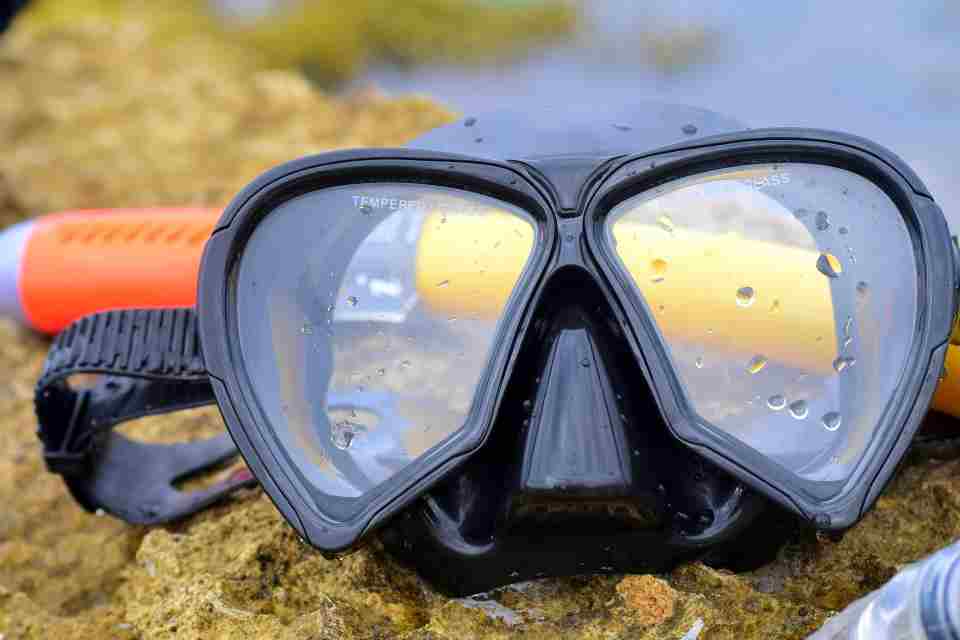- You are here:
- Home »
- Blog »
- Gear Guide »
- Freediving Mask vs Scuba Mask: Here’s how they differ
Freediving Mask vs Scuba Mask: Here’s how they differ

Over the last decade or so, freediving has gone from an absurdly niche sport…to absolutely skyrocketing in popularity.
Because of this, diving shops have now spun out entire product lines of freediving equipment. A notable piece of freediving gear that has some controversy surrounding it, is the freediving mask.
Now you may be wondering…Is there really a difference between a freediving mask vs scuba mask?
Or is it just another clever marketing ploy designed to get us to dig a little deeper into our pockets for yet another freediving gadget we don’t really need?
The answer here is: yes, there really is a difference between a freediving mask vs scuba mask. Freediving masks tend to be smaller, thinner and have less volume. This makes them easier to equalize, so you save more oxygen, are able dive deeper and equalize better at depth. Scuba masks on the other hand tend to be bulkier, have more volume and have greater visibility.
Freediving mask vs scuba mask: what’s the difference?

Freediving masks typically hold less air volume making them easier to equalize.
The main difference between a freediving mask vs scuba mask, is in the shape and design of the masks.
Scuba masks on average are bigger, heavier and have more volume.
Freediving masks, on the other hand, are designed to be shorter, more compact and with less volume.
Let’s take a closer look at the differences and start by looking at the pros & cons of scuba masks:
Scuba masks: the pros
- More common: Scuba diving as a sport is more popular than freediving. For this reason the gear is far more common. This means almost every diving shop will sell scuba masks, so you won’t have to make long treks just to get a mask.
- More likely to fit: As mentioned above, scuba masks are more common than freediving masks. This means you’ll have a much easier time finding a scuba mask that fits the unique mold of your face…without leaking water into your mask.
- Higher volume: The lenses of scuba masks are built to be further away from your eyes. This allows for more air volume (air space) to occupy the inside of your actual mask. This can be good because if water leaks into your mask, then it won’t go straight into your eyes because there’s more space for the water to occupy. Also, if you have long eyelashes, you’ll enjoy being able to blink without your eye lashes hitting the lenses!
- Less claustrophobic: Lenses tend to be wider in scuba masks, boosting visibility and preventing tunnel vision.
Scuba masks: the cons
- Big, bulky design: The heavy, bulky shape of scuba masks can be a little annoying when freediving. You’ll notice there’s a lot more drag and you won’t be gliding through the water as smoothly as if you were barefaced or with a freediving mask. On top of this, large clunky masks can also be dangerous. The reason for this is because big scuba masks tend to have a higher surface area. So if you’re diving in strong currents, it’s easier for the force of the current to latch onto your mask and rip it off.
- Higher volume: The more volume your mask has; the more air you have to exhale into your mask to equalize it to avoid mask squeeze. This means you’ll burn through your oxygen quickly and struggle to equalize your mask at great depths.

Notice how big the lenses of this scuba mask are? That’s because scuba divers have more oxygen to equalize their masks with, so can afford to have larger lenses
Now that we’ve covered scuba masks, let’s take a look at the pros and cons of freediving masks:
Freediving masks: the pros
- Thin, tight and compact: The smooth, slim design of freediving masks makes diving in strong currents a breeze. You won’t have to worry about your mask being torn off your face when you need it most. Lastly, despite being strong and sturdy, freediving masks are also built to be light-weight and easy to move around with – it’s the same light-weight agile feeling you get when wearing high-quality elastomer/carbon fiber fins.
- Less volume: The lenses are much closer to your face, so you need less air to equalize the mask. This saves air in your lungs, so can equalize comfortably at great depths.
- Sleeker design: A minor point, but freediving masks arguably look much cooler than big clunky scuba masks (heavily bias opinion on this one!)
Freediving masks: the cons
- Less common: Freediving masks aren’t very common in your average diving store. You may have to look around a little or search some online stores to find a good one that fits.
- May not fit correctly: As mentioned above, freediving masks are less common. If you have a uniquely-shaped face, you might struggle to find a mask that fits without leaking water in.
- Narrower field of view: Freediving masks have smaller lenses and so aren’t as wide. The downside here is you may feel uncomfortable at first with this ‘tunnel vision’ or limited peripheral view. To counteract this, try buying a freediving mask where the lenses are closer to your face, which allows for a wider field of view.
- Less volume: A small downside of having a mask that is easy to equalize, is that it also fills with water much faster. In other words, if there is a leak, you’ll know all about it from the sting of salt water in your eyes!
Freediving mask vs scuba mask: so…do you need a freediving mask?
You do not need a freediving mask. You can certainly freedive with just a scuba mask. But, if you want to equalize comfortably at deeper depths and maximize your potential as a freediver…you’ll eventually need to make the switch and invest in a freediving mask.
If you’re thinking about investing in a low-volume freediving mask, but not sure where to start, I recommend grabbing the Aqua Lung Sphera X Mask – you can read my post about it by clicking this link here.
As stated before, the main reason freediving masks are better for freediving, is because they have less volume.
A low volume mask is important for freedivers, because it requires less air to equalize, saving more air in our lungs for the rest of our dives. After all, we don’t have big oxygen tanks that let us exhale huge breaths to equalize large-volume scuba masks.
We need to be as efficient as possible with the air in our lungs. That means wearing a small mask that can easily be equalized with short bursts of air.
As a side note: if you aren’t training with an Air Restriction Device (ARD) then you’re leaving untapped breath-holding potential on the table. Low-volume freediving masks may help you conserve oxygen during dives…
But you’re seriously missing out if you aren’t training with an ARD – I’ve written a post about how Air Restriction Devices boost lung/oxygen efficiency, click here to read it.
So do you need a freediving mask as soon as you start freediving?
Do you need a freediving mask straight out the gate?
Or is there a specific depth at which you should switch from a scuba mask to a freediving mask?
Well, I’d say you should be fine using a scuba diving mask up until you’re diving passed about 85 feet deep (~ 25 meters deep). Beyond that, you’ll need more air in your lungs to equalize at greater depths, so you’re better off investing in a freediving mask beyond ~ 85 feet deep.
In my personal opinion – it’s better to just invest in proper freediving gear – even if you’re a beginner. Not only is it safer and will give you time to get used to wearing it all…
But wearing good freediving gear is also a nice motivation boost to help push you further and fully immerse yourself in the sport.
If you’re serious about tapping into your full potential as a freediver, not only should you invest in a freediving mask, but also you’ll need to invest in the correct freediving weight belt (one that doesn’t cut off your oxygen supply during your breathe-up!).
What to look for when buying a freediving mask?
- Material: Generally speaking; the best freediving masks are made of silicone. Silicone is a durable yet flexible material. This stops your mask from easily breaking, getting cracks in the hot sun or snapping under pressure. Silicone is also very chemical-resistant, which is important if you’re practicing apnea in pools with chlorine.
- Silicone Strength: It’s best to choose silicone that is reasonably strong, yet not too hard against your skin. It should feel comfortable to wear, yet still stop water leaking in. The only exception to this is if you have thick and/or long facial hair. If you do sport a beard: you may want to buy a mask with hard silicone. The hard silicone will press your beard hair down to stop water leaking in. (or you can simply shave and wear a softer silicone mask if you want a more comfortable fit)
- Color: When talking about the color of a freediving mask; I’m talking about the color of the skirt (the silicone flap surrounding the frame that seals to your face). Typically the best freediving masks come in black.Black skirts on masks help protect your eyes from the sun and blocks your peripherals better. This is both good and bad. Good, because the black skirt refines your vision and causes you to focus on what is directly in front of you. This is especially useful if you’re into underwater photography. Black skirts can, however, be bad because it gives you ‘tunnel vision’ which can be uncomfortable and too dark for newer divers. If that’s you, you may be better off with a white skirt.White skirts give you a clear, see-through, well lit up diving experience. You won’t experience any tunnel vision and you’ll likely be able to see more out your peripherals. The negatives are that it can be blinding in sunny weather and your vision won’t be as focused.
- Fit: Does it fit your face? In general there are 3 features to check when fitting a mask:1. Check the skirts are wide enough to make a comfortable seal on your face.
2. Check the bottom of the mask seals tightly to your nose and mouth area.
3. Check whether the mask fits the general shape of your face.To help you do point 3: Press the mask against your face as if you are wearing it. The straps should not be around your head (dangling underneath is fine). Now breathe in through your nose and let go of the mask. The mask should be sucked tightly to your face. You should hear no noise of air whistling through into the mask. This means it’s water tight and is a good fit.
- Buckle Strength: You should be able to pull on the straps and buckles of the mask without them sliding out of place. The buckles should also be adjusted so your mask is tight enough to stop water leaking in (but not so tight you have impressions on your face after removing the mask!). If you like having your snorkel on the inside of your mask strap: make sure your mask strap is loose enough to allow for the snorkel to fit. Otherwise feel free to tighten the strap and keep the snorkel on the outside (just make sure you clip it tightly!).
- Lens Width: This mainly comes down to personal preference. Large lenses allow for a much wider field of view. If you care about having a large field of view, get big lenses or lenses that are closer to your face.
- Air volume: As covered above, it’s usually best to go with a mask with lower air volume.
The Aqua Lung Sphera Freediving Mask ticks all the above boxes, which is why it’s one of the most popular freediving masks on the market.
You can get your Aqua Lung Freediving Mask for the price of less than a week’s worth of groceries by clicking this Amazon link here.
What snorkel should you use with your freediving mask?
When it comes to freediving, you don’t really need a complex, top of the line snorkel.
Many expensive snorkels often come with intricate purge valves, specialized mouth pieces and bulky splash guards.
If you’re freediving: you don’t really need any of this.
All you need is a short, basic, J-shaped snorkel. It’s important to use a snorkel that is short and simple so you reduce drag and maximize underwater thrust. Also, if possible, try to use a snorkel that is quite soft and flexible. That way it bends around your head making you more hydrodynamic.
I recommend the Kraken Aquatics freediving snorkel. It ticks all the boxes above and is VERY affordable Click here to see it on Amazon.
About the Author Gerrie van Niekerk - Apnealogy
Gerrie is a passionate Freediver, Spearfisher, Digital Marketer, and author for the Apnealogy website. Gerrie is an SSI Level 1 certified Freediver who loves geeking out about freediving and spearfishing gear and lives for his family and adventure.


